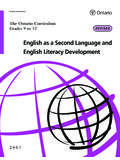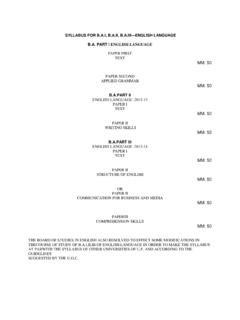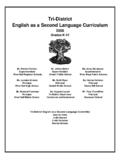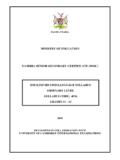Transcription of Curriculum - Second Language - Langue Deux - …
1 2012-08-D -13-en-2 1 European Schools Office of the Secretary-General Pedagogical Development Unit Ref.: 2012-08-D-13-en-2 Orig.: EN Curriculum - Second Language - Langue deux - Zweite Sprache APPROVED BY THE JOINT TEACHING COMMITTEE Meeting on 11 and 12 October 2012 Brussels Entry into force: 1st September 2013 2012-08-D -13-en-2 2 Curriculum Second Language Langue deux ZWEITE SPRACHE INTRODUCTION On the basis of the existing three different syllabuses for Language II1 in english , French and German a Joint Working group Language II started to develop a combined Curriculum taking into consideration recent developments in the European Union and in the Council of Europe. The Common Curriculum is based on the Common European Framework of Reference for the Teaching and Learning of Foreign Languages (published by the Council of Europe 2001) and the European Framework for Key Competences for Lifelong Learning (published by the European Commission 2006).
2 This Curriculum replaces the Curriculum sections of the original document: 92-D-296-en (Guidelines for Second Language teaching in the primary sections) It takes account of the following documents: 2012-01-D-36-en-5 (Working Group Languages : final proposal Proposal A) 2011-09-D-47-en-3 (New structure for all syllabuses in the system of the European schools) 2011-01-D-61-en-3 (Assessment policy in the European schools) The Curriculum is based on expert advice based mainly on the in-depth work in the fourteen European schools. It reflects a common, harmonised basis in the field of modern languages for the European Schools in its objectives, contents and methods. These are already used by many national systems. The Curriculum focuses on the competences to be attained by the end of primary education. Language learning is seen as a continuous step-by-step learning process taking into consideration the individuality of each student.
3 Teachers must take account of the individual pupil s starting point on the Language continuum and must differentiate accordingly. The Curriculum includes general objectives, didactic principles, teaching and learning objectives, contents and assessment. It presents the linguistic items students will be expected to learn, and describes the competences they will develop in order to communicate effectively. Together with the need for formative, diagnostic and summative assessment of pupils Language II learning, there is also place for pupils self-assessment and the development of pupil portfolios. The Curriculum is accompanied by an individual syllabus for each of the three vehicular languages French, english and German - focusing on the aspects of each Language and providing practical support for content-area based planning and examples of good practice.
4 The Curriculum for all L II languages will come into force in September 2013 1 The study of an L II, ab initio, is compulsory for all primary students from Year 1 to Year 5. Students may choose one of the three vehicular languages of the European Schools, english , French or German, as L II, but the Language chosen must be different from that studied as L I. The learning objectives up to the end of Year 5 are based on five years (two and a half periods per week) of continuous study of the Language .) 2012-08-D -13-en-2 3 1. GENERAL OBJECTIVES OF THE EUROPEAN SCHOOLS The words which express the essential aims of the European Schools have been sealed, in parchment, into the foundation stones of all the schools: Educated side by side, untroubled from infancy by divisive prejudices, acquainted with all that is great and good in the different cultures, it will be borne in upon them as they mature that they belong together.
5 Without ceasing to look to their own lands with love and pride, they will become in mind Europeans, schooled and ready to complete and consolidate the work of their fathers before them, to bring into being a united and thriving Europe. The European Schools have the two objectives of providing formal education and of encouraging pupils personal development in a wider social and cultural context. Formal education involves the acquisition of competences knowledge, skills and attitudes across a range of domains. Personal development takes place in a variety of spiritual, moral, social and cultural contexts. It involves an awareness of appropriate behavior, an understanding of the environment in which pupils live, and a development of their individual identity. These two objectives are nurtured in the context of an enhanced awareness of the richness of European culture.
6 Awareness and experience of a shared European life should lead pupils towards a greater respect for the traditions of each individual country and region in Europe, while developing and preserving their own national identities. The pupils of the European Schools are future citizens of Europe and the world. As such, they need a range of competences if they are to meet the challenges of a rapidly-changing world. In 2006 the European Council and European Parliament adopted a European Framework for Key Competences for Lifelong Learning. It identifies eight key competences which all individuals need for personal fulfillment and development, for active citizenship, for social inclusion and for employment: 1. communication in the mother tongue 2. communication in foreign languages 3. mathematical competence and basic competences in science and technology 4.
7 Digital competence 5. learning to learn 6. social and civic competences 7. sense of initiative and entrepreneurship 8. cultural awareness and expression The European Schools syllabuses seek to develop all of these key competences in the pupils. Objectives for L II Languages Among the general objectives defined by the European Schools are the following that are specific to teaching and learning languages: to give pupils confidence in their own cultural identity the bedrock for their development as European citizens; to develop high standards in the mother tongue and in foreign languages; 2012-08-D -13-en-2 4 to encourage a European and global perspective overall and particularly in the study of the human sciences; to foster tolerance, co-operation, communication and concern for others throughout the school community and beyond; to cultivate pupils personal, social and academic development and to prepare them for the next stage of education.
8 C/f ( ) In particular, the primary cycle of the European Schools has the following objectives: teaching pupils acquisition of literacy skills providing formal, subject based education encouraging students personal development in a wider social and cultural context. The Language II Curriculum makes a significant contribution not only to the development of communicative competences, but also to social and civic competences and to the students cultural awareness and expression. Language learning gives pupils a good base for acquiring other languages and for developing their individual personalities. The learning objectives are benchmarked against the reference levels of the Council of Europe s Common European Framework of Reference for Languages (CEFRL). The first three levels of achievement are relevant for L II education at primary level: A 1 Breakthrough A 2 Waystage B 1 Threshold Students with no command of the Second Language when entering schooling in Primary Class 1 should reach level A2 by the end of primary education.
9 Students with an advanced level of Language competence could reach level B1, at least in some of the competence areas. 2. DIDACTIC PRINCIPLES Language learning is part of a holistic process involving all the senses. Pupils should be enabled to use Language in context through project-based enquiry. Planning for teaching and learning in Language II must take into account the prior skills, knowledge and requirements of the learners. Teachers must also be cognisant of research and development in terms of Language acquisition, as outlined in the "Common European Framework of Reference for Languages: learning, teaching and assessment". The Joint Language II Curriculum is based on a dynamic concept of continuous competence building. The L II Curriculum is based on a dynamic model of teaching and learning.
10 The teacher should create a motivational, stimulating learning background through an activity-based and thought-provoking learning environment, including the modelling and scaffolding of new learning and careful monitoring of the progress each pupil is making. The learner must be an active participant, aware of his/her learning processes and adopt an active role in this process. 2012-08-D -13-en-2 5 The Curriculum takes as a key principle that the first Language provides the foundation for Second Language acquisition, that learning in L I and L II share common features and that it is vital to make salient links between both for pupils. Second Language teaching should, where possible, maximize existing or recent learning contexts in the first Language class. Language development should be seen as holistic in nature so that development in one aspect supports learning in another.







